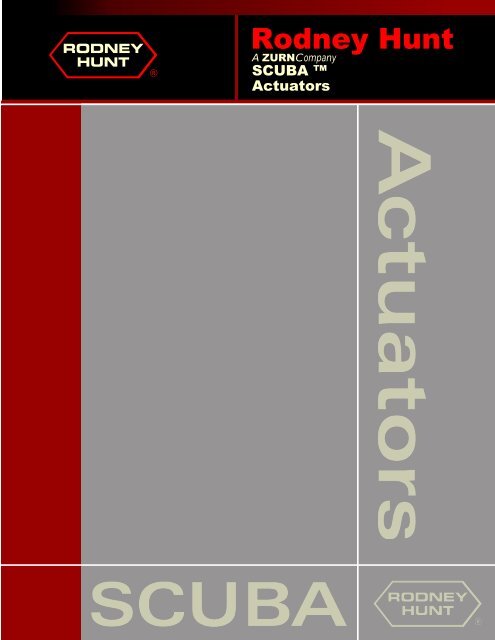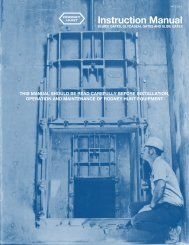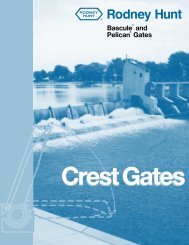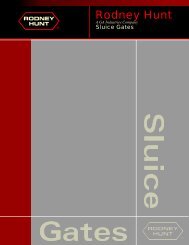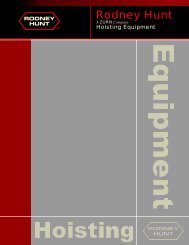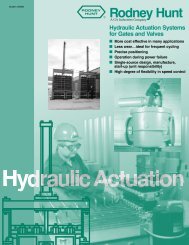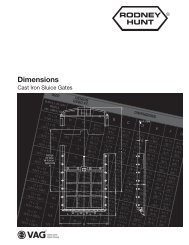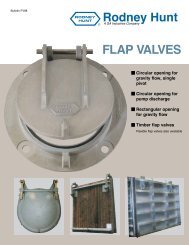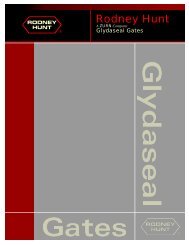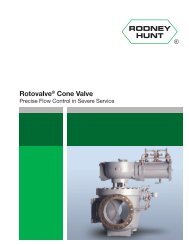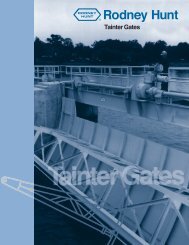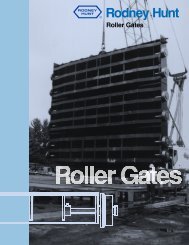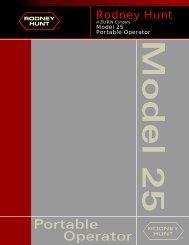scuba - Rodney Hunt Company
scuba - Rodney Hunt Company
scuba - Rodney Hunt Company
You also want an ePaper? Increase the reach of your titles
YUMPU automatically turns print PDFs into web optimized ePapers that Google loves.
<strong>Rodney</strong> <strong>Hunt</strong><br />
A ZURN <strong>Company</strong><br />
SCUBA <br />
Actuators
SCUBA. In the <strong>Rodney</strong> <strong>Hunt</strong><br />
Tradition of Quality and Reliability<br />
Submersible SCUBA unit, designed<br />
for hazardous duty in a combined<br />
sewer regulation chamber.<br />
Rugged, practically maintenance-free, the SCUBA unit is a linear<br />
actuator designed for heavy-duty applications where dependable<br />
long-term service is required. The SCUBA unit is part of a long line of<br />
quality products from <strong>Rodney</strong> <strong>Hunt</strong>, a leader in the design and<br />
manufacture of gates, valves, and actuation equipment for liquid<br />
control applications around the world.<br />
SCUBA units are compact, self-contained electrohydraulic<br />
actuators that were designed for gate and valve actuation, but can be<br />
easily used with almost any device requiring linear actuation. A simple<br />
mechanical connection to the device, and a straightforward electrical<br />
connection to the control panel, makes the field installation of SCUBA<br />
quick and easy.<br />
SCUBA is ideal for a wide variety of applications where<br />
accessibility may be difficult, where modulating service is required, or<br />
anywhere a low maintenance linear actuator is desired. With many<br />
standard options, an economical SCUBA unit can be configured for<br />
long, dependable service in hazardous, submersible, and corrosive<br />
environments. Our engineers can add special features to satisfy the<br />
most demanding applications.<br />
<strong>Rodney</strong> <strong>Hunt</strong>’s SCUBA unit is available with<br />
a weather-tight cover for outdoor installations.
SCUBA. Provides Self-Contained,<br />
Low-Maintenance Actuation.<br />
Dual manual hand<br />
Pump option provides<br />
operation during a power<br />
outage. Shown here with<br />
special locking hardware.<br />
Other power failure options<br />
include automatic<br />
retraction or extension.<br />
A variety of covers are<br />
available for every<br />
application.<br />
Stainless steel tubing with<br />
silver brazed, O-ring face<br />
seal fittings provide a leakfree<br />
system.<br />
Electric motors are<br />
available in a wide variety<br />
of standard voltages,<br />
phases, and ratings. Photo<br />
shows an explosion-proof<br />
motor.<br />
Independent, dual thrust<br />
adjustments are standard<br />
on every SCUBA actuator.<br />
This permits separate<br />
thrust limitation for the<br />
extension and retraction<br />
stroke of the actuator.<br />
Optional continuous<br />
position feedback allows<br />
for remote position<br />
indication and control of the<br />
actuator throughout its<br />
entire stroke.<br />
Stainless steel<br />
case, grade A<br />
pressure gauges<br />
provide indication for<br />
initial adjustments<br />
and monitoring of<br />
system's operating<br />
characteristics.<br />
Manifold cartridge<br />
valving eliminates the<br />
need for line mounted<br />
valves. Optional hand<br />
pump manifold illustrated.<br />
The SCUBA actuator differs from<br />
traditional manual and electric<br />
Actuators. SCUBA units are designed to<br />
be completely self-contained, and<br />
appropriate for a wide range of<br />
applications.<br />
Key Benefits:<br />
• Self-Contained: All actuator<br />
components installed on a common<br />
base.<br />
• Cost Effective: Reduced installation,<br />
maintenance and operating<br />
costs.<br />
• Easy Installation: one mechanical<br />
connection. No field piping.<br />
Straightforward wiring.<br />
• Rugged Design: 1 1/4" base plate.<br />
Stainless steel cover available.<br />
• High Efficiency: Negligible mechanical<br />
losses. No screw stem friction or wear.<br />
• Low Maintenance: No routine<br />
maintenance required .<br />
Standard arid Custom Options<br />
• Optional Covers: Covers available to<br />
meet most applications (such as<br />
weather-tight and submersible).<br />
• Hazardous Environments Explosionproof<br />
and intrinsically safe components<br />
permit installation in hazardous<br />
environments.<br />
• Power Failure Operation: Able to fully<br />
retract or extend upon loss of electrical<br />
power.<br />
• Position Feedback: End of travel and<br />
continuous position feedback is<br />
available.
Where are<br />
SCUBA. Units Used?<br />
Combined Sewer Overflow Regulation<br />
SCUBA's self-contained and rugged construction makes<br />
it ideally suited for the wet, corrosive and hazardous environment of<br />
combined sewer overflow regulator chambers.<br />
Modulating Service<br />
Reduced mechanical wear and maintenance costs make a SCUBA unit the<br />
logical choice for modulating service.<br />
Corrosive Installations<br />
SCUBA units are supplied with <strong>Rodney</strong> <strong>Hunt</strong>'s standard epoxy paint system<br />
which protects the unit in most corrosive applications. For extremely<br />
corrosive environments, SCUBA units can be supplied with stainless steel<br />
covers.<br />
Submersible Locations<br />
A submersible SCUBA unit can be specified for operation in an underwater<br />
location.<br />
Hazardous Environments<br />
SCUBA units can be supplied for installation in Class I, Division 1 hazardous<br />
locations by utilizing explosion-proof and intrinsically safe components.<br />
Emergency Power Failure Operation<br />
Unlike electric actuators, SCUBA units can be supplied to automatically<br />
extend or retract upon a loss of electrical power. Emergency operation is<br />
often critical for influent chambers or pump stations.<br />
Remote Installations<br />
For very remote sites, SCUBA units can be supplied with manual pumps or<br />
12 VDC motors for operation with a vehicle's battery system.<br />
A SCUBA unit can be used to<br />
operate large water and<br />
wastewater control valves like<br />
this 36" Rotovalve, destined for<br />
service in a municipal sewage<br />
treatment facility.<br />
CONFIGURATION<br />
(EXAMPLE)<br />
Pipe Line<br />
or Liquid Channel<br />
SCUBA Unit<br />
Mounting<br />
Bracket<br />
Stem Guide<br />
Stem<br />
Gate<br />
or Valve
Specifications<br />
The following is a sample specification for <strong>Rodney</strong> <strong>Hunt</strong> <strong>Company</strong>'s SCUBA series of linear actuators.<br />
The sample specification is divided into distinct sections, each dealing with a particular aspect or<br />
feature of the SCUBA unit. The specifier is encouraged to read each section carefully and choose the<br />
appropriate subsection that best meets the application.<br />
Although a SCUBA unit can be specified and designed for almost any type of application and<br />
configuration, only the standard features have been included here. If an application requires a special<br />
design consideration, application assistance is available from <strong>Rodney</strong> <strong>Hunt</strong> <strong>Company</strong>.<br />
General: A complete electrohydraulic actuator system shall be<br />
Nonhazardous environment. All electrical components shall be rated NEMA 12<br />
furnished to operate the equipment specified. The design shall be directed, or better.<br />
reviewed and approved by a Professional Engineer registered in the state of Hazardous: The actuator shall be designed to be installed i n a Class I,<br />
manufacture of the actuator system. It shall be equivalent in design and Division 1 hazardous area. All components of the actuator shall be NEMA 7,<br />
workmanship to the SCUBA unit, as manufactured by <strong>Rodney</strong> <strong>Hunt</strong> <strong>Company</strong> Class I, Division 1 rated or wired for intrinsic safety.<br />
of Orange, Massachusetts.<br />
Electrical Control Enclosure Select one:<br />
It is the intent of this specification to encourage the use of the latest ENEMA 12: The separate electrical enclosure and all components mounted on<br />
technological advances both in component selection and in system design its exterior shall be NEMA 12 rated.<br />
concepts.<br />
NEMA 4X: The separate electrical enclosure shall be corrosion resistant and<br />
Actuator Construction: Each actuator shall be designed to be a single self- NEMA 4X rated. All components mounted on the exterior of the enclosure shall<br />
contained unit, requiring only electrical connections. The actuator shall be be NEMA 4 rated<br />
completely factory wired, assembled and tested.<br />
NEMA 7: The separate electrical enclosure and all components mounted on<br />
The operating rod and any required operating stem shall be sized to safely the exterior shall be NEMA 7 rated and designed for installation in a Class 1,<br />
withstand 1.25 times the actuator output at maximum system pressure and Division 1 hazardous environment.<br />
shall be sized so that L/r is less than 200; where "L" is the unsupported length Integral: The electrical enclosure shall be an integral part of the actuator<br />
and "r" is the radius of gyration. The operating rod shall be hard chrome cover. All necessary electrical control components shall be mounted on/in the<br />
plated. Any additional stem required shall be stainless steel.<br />
integral enclosure.<br />
All hydraulic tubing shall be 300 series stainless steel with O-ring face seal, Controls Select all that apply:<br />
sil-brazed fittings meeting the requirements of SAE J1453.<br />
Local Extend/Retract: It shall be possible to extend, retract, and position the<br />
All electrical connections shall be made within conduit enclosures or actuator using manually activated pushbuttons located on the control<br />
junction boxes and be properly labeled. No live connections shall be exposed enclosure. It shall be possible to position the gate at any intermediate position.<br />
when the unit cover is removed. If analog signal wiring is required, it should Remote Extend/Retract: It shall be possible to position the actuator using two<br />
be shielded and separated from the control and power wiring.<br />
sets of normally open dry contacts provided from devices by others. Motion<br />
Actuator Cover Select one:<br />
occurs while these contacts are closed and ceases when they are open.<br />
Drip-Proof Cover: The actuator cover shall be manufactured so that it Modulating: It shall be possible to position the actuator automatically using a<br />
protects the actuator from the entrance of rain.<br />
single loop controller in order to match a variable 4-20 mAmp process signal.<br />
Weather-Tight Cover: The actuator cover shall be manufactured so that it The controller shall be capable of proportional-integral-derivative (PID) control.<br />
protects the actuator from windblown rain, splashing water, or hose-directed The analog process variable signal to be monitored shall be provided from<br />
water.<br />
devices furnished by others.<br />
Submersible Cover: The actuator cover shall be manufactured so that it will Special Controls: Specify as required.<br />
exclude water in a submerged condition.<br />
Position Indication Select one:<br />
Without Cover: The actuator shall be provided without a cover.<br />
End of Travel: End of travel indicating lights, mounted on the control<br />
Cover Material Select one:<br />
enclosure, shall be provided using proximity switches integrally mounted in the<br />
Steel: The actuator cover material shall be steel.<br />
actuator.<br />
Stainless Steel: The actuator cover material shall be stainless steel. Continuous Position Indication: The actuator shall be supplied with a 4-20<br />
Nominal Speed Select one:<br />
mAmp continuous position transducer. The actuator's position shall be<br />
12"/min.: The actuator shall extend and retract at a nominal speed of 12" per displayed on an LED meter, mounted on the control enclosure.<br />
minute.<br />
End of Travel and Continuous Position Indication: The actuator shall be<br />
24"/min.: The actuator shall extend and retract at a nominal speed of 24" per supplied with both a 4-20 mAmp continuous position transducer and end of<br />
minute.<br />
travel proximity switches. The control enclosure shall be provided with an LED<br />
Power Failure Operation Select one:<br />
meter and indicating lights.<br />
Automatic Extension: Upon a loss of electrical power, the actuator shall None Required: No position indication is required.<br />
immediately and automatically fully extend at the normal operating speed. Electrical Power: The main electrical power source shall be:<br />
Automatic Retraction: Upon a loss of electrical power, the actuator shall (120-1 ) (208-1 ) (208-3 ) (230-1 ) (230-3 ) (480-3 )<br />
immediately and automatically fully retract at the normal operating speed. Testing: The actuator shall be thoroughly shop tested to verify that all modes<br />
Manual: Manual operation shall be provided, at a reduced speed, in the event of operation perform as required. Testing shall include verification of motor<br />
that there is no electrical power available. All manual operation shall be operating running amps and voltage; actuator operating speed and stroke; and<br />
possible without opening the actuator cover. No directional control valves will verification of the extension and retraction thrust adjustments.<br />
be allowed.<br />
Painting: The actuator shall be painted with one coat of medium gray high-<br />
None Required: No power failure operation is required.<br />
solids epoxy (5 mils), followed by one coat of medium gray aliphatic<br />
Actuator Environment Select one:<br />
Non-Hazardous: The actuator shall be designed to be installed in a<br />
polyurethane (2 mils).


